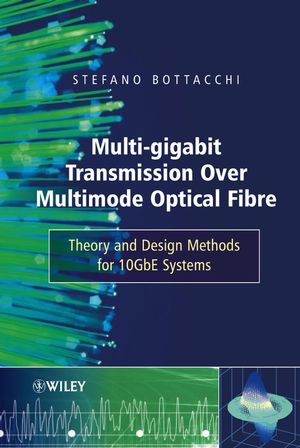Multi-Gigabit Transmission over Multimode Optical Fibre: Theory and Design Methods for 10GbE SystemsISBN: 978-0-471-89175-8
Hardcover
670 pages
August 2006
 This is a Print-on-Demand title. It will be printed specifically to fill your order. Please allow an additional 15-20 days delivery time. The book is not returnable.
|
||||||
Book Organization.
1. Introductory Concepts.
Components and Design Issues for a Multigigabit Link over Multimode Fiber.
1.1 Introduction.
1.2 Multimode Optical Fibers.
1.3 Semiconductor Laser Sources.
1.4 Offset Launch Conditions.
1.5 Optical Receivers.
1.6 Signal Compensation Techniques.
1.7 Conclusions and Recommendations.
1.8 Optical Fiber Transmission Standards.
2. Conductive Transmission Lines.
A Simplified Attenuation Model.
2.1 Introduction.
2.2 The Attenuation Model.
2.3 Design Applications.
2.4 Impulse Response.
2.5 Conclusions.
3. Principles of Multimode Optical Fiber.
Theory and Modeling Issues for Multigigabit Transmission Links.
3.1 Introduction.
3.2 The Graded Refractive Index.
3.3 Modal Theory of Graded Index Fiber.
3.4 Theory of the Modal Impulse Response.
3.5 Linear Propagation Regime.
3.6 The Optimum Refractive Index.
3.7 Physics of the Chromatic Dispersion.
3.8 Waveguide Dispersion.
3.9 Frequency Chirping.
3.10 Higher-Order Linear Dispersion.
3.11 The Gaussian Model.
4. Theory of Chromatic Response.
Modeling Light Source Effect in Multigigabit Transmission Links.
4.1 Introduction and Outline.
4.2 Theory of Chromatic Impulse Response.
4.3 The Chromatic Impulse Response Model.
4.4 Moments of Chromatic Impulse Response.
4.5 Conclusions and Remarks.
5. Theory of Multimode Response.
Application to Multigigabit Transmission Links.
5.1 Introduction and Outline.
5.2 Moments of Modal Impulse Response.
5.3 Theory of Multimode Impulse Response.
5.4 The Multimode Impulse Response Model.
5.5 Theory of Multimode Frequency Response.
5.6 Summary and Conclusions.
6. Gaussian Approximation and Applications.
Link Bandwidth Calculations.
6.1 The Gaussian Model Approximation.
6.2 Comparing Engineering Solutions.
6.3 Comparison with Transmission Lines.
6.4 Conclusions and Remarks.
7. Multimode Fiber Selected Topics.
Impairments and Methods for Multigigabit Transmission Links.
7.1 Impulse Response and Modal Bandwidth.
7.2 Modal Theory of the Step-Index Fiber.
7.3 Mode Power and Launch Conditions.
7.4 Conclusions.
8. The Optical Link Model.
Modeling the Optical Channel Behavior for Multigigabit Transmission.
8.1 Introduction.
8.2 System Models and Assumptions.
8.3 The Optical Transmitter.
8.4 Intersymbol Interference.
8.5 The Optical Receiver.
8.6 Conclusions.
9. Principles of Electronic Dispersion Compensation.
Concepts and Limitations Applied to Multimode Fiber Transmission.
9.1 Introduction.
9.2 The Optical Decision Process.
9.3 Principles of Linear Equalization.
9.4 Conclusions.
10. Decision Feedback Equalization.
Expanding Multimode Fiber Capabilities.
10.1 Introduction.
10.2 Principles of Digital Equalization.
10.3 The Optical Power Penalty.
10.4 The Channel Metric.
10.5 DFE Architectures.
10.6 Conclusions.
11. Transmission Experiments.
Deploying Multigigabit Transmission Experiments over Multimode Fiber.
11.1 Introduction.
11.2 Measurement Outline.
11.3 Measurement Setup.
11.4 Polarization Effects in Multimode Fiber.
11.5 Source and Receiver Characterization.
11.6 The Benchmark Multimode Fiber.
11.7 A Simple Optical Link Emulator.
11.8 Polarization Measurements at 10 GbE.
11.9 EDC Measurements over MMF.
11.10 Concluding Remarks.
Bibliography.
Index.



